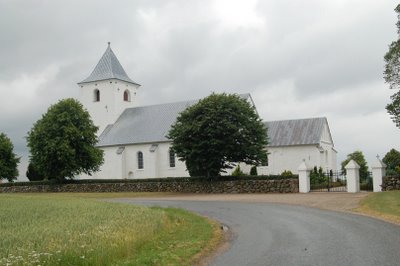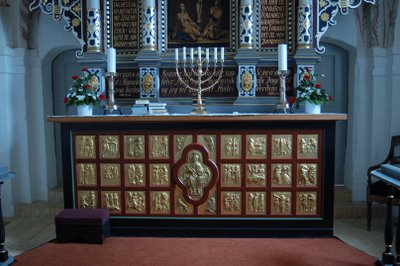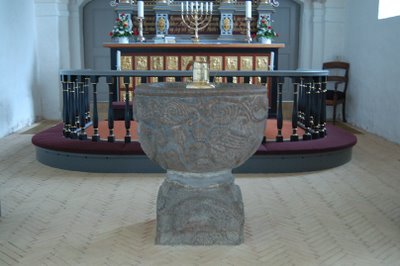
Tamdrup Church, ab. 10 km northwest of Horsens
Tamdrup sogn, Nim herred, Skanderborg amt
The large church in Tamdrup lies upon the top of a hill and is seen so far away that it once was used as a seamark at Horsens Fjord. It is one of the oldest and strangest stone buildings in Denmark, closely related to Vor Frue Church in Roskilde. Powerful people, maybe the king was the building master, but the building is now marked by a thorough change made in the late Middle Ages, maybe in 1463. The large stone church was according to dendrochronological datings from timber in windows and nave built in the last decade of the 1000s - and probably finished ab. 1125. The Romanesque church consisted of apse, choir and an unusually broad nave. The decorations of the flank walls belong to the oldest Anglo-Saxon marked Danish church architecture. Tamdrup church belongs to the most important historic monuments in Denmark. It has some of the oldest frescoes in the country and one of the most important documents of the history about the introduction of Christianity in Denmark, a golden altar showing the famous representation of 'Poppos Jernbyrd' and Harald Bluetooth's christening.

The church might have been planned as a cross-armed church, but the project was changed at the building of the nave in the beginning of the 1100s. Instead was built a three-naved basilica with a room divided by pillars and arcade walls opening to the side naves. The pretty Romanesque construction was unfortunately radically rebuilt in the Gothic period in the middle of the 1400s. The apse to the east was broken down and the choir extended to double size. The nave had built in four bay cross vaults, which removed half the arcade pillars, and the rest was built in the new walls. The apses of the side-naves were broken down and finally was built a late Gothic tower to the west in monk bricks and a porch on the north side of the nave in front of the north door. Tower and porch from 1450-1500.

The golden altar in Tamdrup. The present front of the altar is a cast of the original gilt copper reliefs which are at the National Museum. It cannot be said for certain if the copper plates belong to an altar or maybe to a reliquary, which might have been made for Poppo. The last suggestion is in connection to Tamdrup church's function as a place of pilgrimage. The casts are today placed in three rows with Christ in the middle. The story of the plates are actually four stories, which very well indicate that they might have belonged to a four-sided box. The dating is uncertain. The historical event, Harald Bluetooth's christening happened in the late 900s, but compared to other golden altars the Tamdrup altar is dated to ab. 1200. It is probably older, although the earliest making must have been in the 1100s, maybe on connection to the inauguration of the church.


The church owns another magnificent piece: the baptismal font is one of the best Romanesque granite fonts in Jutland with its unusual motives. The Jutland lions have here been replaced by the Evangelist symbols in high relief surrounded by fine leaf-windings and human figures (the Evangelists) and upon the foot various angels. The Tamdrup font's motives underline a close connection between the four lion-figures on the usual lion fonts and the four Evangelists.

The Romanesque frescoes on the choir wall in Tamdrup belong to the earliest in Denmark, dated to 1100--1125. The preserved frescoes have been parts of a larger decoration . The painter belonged to the workshop, which a little earlier created the decorations of the choir in Jelling church. The choir vault's frescoes are from the late 1400s.

The cathedral -like church in Tamdrup was regarded as a sort of memorial church for the introduction of Christianity in Denmark. Its situation inside the domain of the Jelling dynasty and the rich Romanesque works of art, in which Harald Bluetooth's conversion to Christianity plays a central part, makes it reasonable to point to a royal building master, who wanted to emphasize the divine basis of the royal family - and this must be either Erik I Ejegod or king Niels. It was Erik Ejegod, who placed a independent archbishopric for the North in Denmark.
Erik Ejegod was known as a man of the church , and he went as a Christian king on a pilgrimage, which was fatal to him and his queen. Whoever the building master was, the church came soon into the ownership of the Århus bishop. In written sources Tamdrup church is first mentioned in July 1279 in a letter of bishop Tyge 2. of Århus in connection to a church meeting in Vejle. The connection to the church is seen from the neighbouring farm, Tamdrup Bisgård, which must have been the old bishopical residence. When the church was rebuilt in the 1400s it was ordered from the bishop. Upon the choir vault is the coat of arms of the bishop in Århus 1491-1520, Niels Clausen Skade. After the reformation the Catholic church lost all its possessions, i.e. Tamdrup church and the bishop's residence, Tamdrup Bisgård.

Tamdrup Bisgård and the church on top of the hills.
Tamdrup Bisgård belonged in the Middle Ages to Århus bishopric, later it was under Stjernholm vasalry and was occupied in 1578 by Anders Grøn,, whose widow in 1580 by the Crown got a life's letter on the farm. The son Holger Grøn is mentioned in B. in 1603 and 1621 and his heirs in B. in 1649. In 1664 it was by the Crown conveyed to Samuel and Jacob Isak de Lima. Later owners: Müller; Nansen; Olufsen Svane; Mandix; Hasselbalch; Secher; Reedtz; Lorentzen: From 1961 Karen M. Bentzen, née Juel.
The main buildin g is like the church situated high upon a range of hills and is visible far and wide. The half-timbered plan is from ab. 1784, built by Ole Mandix after the earlier buildings had burnt down. The two stables buildings in granite boulder are from 1894 and 1895.
Årupgård belonged in the Middle Ages to Ring kloster; in 1559 it was by Herluf Trolle endowed to Dorothea Sehested; in 1627 it was by the Crown transferred to Holger Grøn and then to his son, Anders Grøn (+ ab. 1649). In 1668 the Crown conveyed Å. and estate to mayor in Horsens Peder Jensen Hammel (+ 1680). Later owners: Eisbøll; Hegelund; Hofgaard; Fussing; Wellejus; Bjørn; Frich; Winther. In 1961: Landbrugernes Sammenslutning. - The main building was built in 1872 after a fire.
Marienborg was built by Ole Mandix of Bisgård in the late 1700s.
Provstlund belonged in 1495 to Voer kloster. The present farm was gathered according to royal permission of 1843 and 1851 by A.T. Schütte of Bygholm.
Vintenlund conveyed Otte Limbek of Boller in 1350 to Voer kloster.
In the northern outskirts of Vinten skov (forest) is the prettily kept double castle bank Drostholm or "Æ Hummelgaardsknold." It consists of a southeastern rectangular bank (ab. 30 x 27 m and ab. 2 1/2 m high, and a southwestern circular bank of almost the same height, (diameter 35 m), both surrounded by and each divided by moats, which originally were water-filled, but now are almost overgrown. Outside the moats are to the north and south towards the square bank an earth bank or dam, maybe leftover-earth from the moat. Upon the square bank have been found monk bricks; it has a vague hollow in the middle and out to the side towards the circular bank. This bank has no top-surface, but a vaguely slanting side to the top-point. In the forest south of the castle bank were various dikes and banks, but they are now flattened out.
Names in the Middle Ages and 1600s: Tamdrup kirke (* 1279 Thomæthorp, 1345 Tummæthorp); Lund (* 1350 Wintenlund, * 1453 Lundt, Vinthenlundt); Vinten (1488 Venthen, 1492 Vinthen, Winthen); Kørup (1492 Kørop); Vrønding ( * 1440 Vrønding, 1488 Vronningh); Molger (* 1448 Malgaard, 1492 Molger); Enner (* 1415 Ennir, 1492 Æner); Tamdrup Bisgård
(*1486 Bischobs gaard, 1492 Bisgard); Provstlund (* 1490 Proustlund); Årupgård (* 1274 Atrop marck, 1459 Oruplund, 1559 Aarupegaard); Herløkke (1682 Herre Lycke).
Listed prehistorics: In Lund skolehave (schoolgarden) was a small passage grave with an oval chamber, built by 9 supporting stones, but without cover stones. Furthermore a hill at Tamdrup Møllegård's land, close to Tamdrup Bavnehøj, where was a group of 8 hills.
Demolished or destroyed: 3 stone graves and 62 hills, which mainly were in the high land in the western part of the parish. - Along Hansted Å (river) were several settlements from early Stone Age. At Årupgård was an important depot or sacrifical finding from dyssetiden (early Stone Age): a clay vessel, (eye-vessel), where were 7 thin copper spirals and a pipe in copper, and 272 amber pearls, besides many pieces of amber. At the place is also a settlement from a later section of late Stone Age, jættestuetiden (passage grave period).
Source: Niels Peter Stilling, Danmarks kirker, 2000; Trap Danmark, Skanderborg amt, 1964.

photo Tamdrup kirke: grethe bachmann
No comments:
Post a Comment